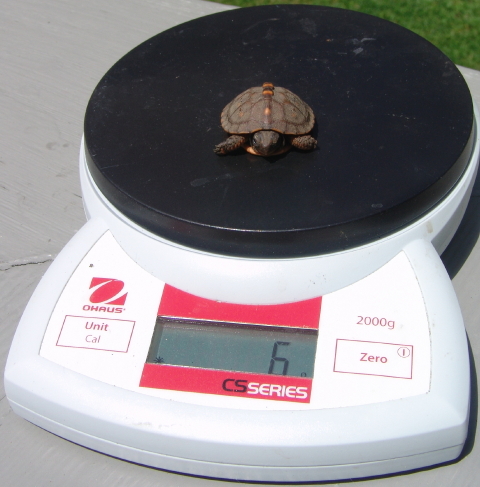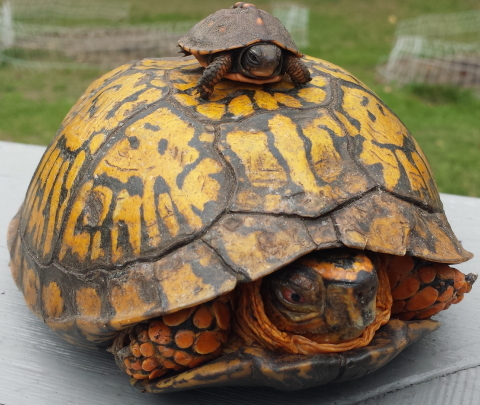Eastern Box Turtle (Terrapene carolina carolina) Hatchling
The Turtle Journal team was shocked this morning to find a tiny Eastern box turtle hatchling that had emerged from its first winter brumation (hibernation). Â Discovering a hatchling or yearling box turtle, after they have left the nest and disappeared into the wild, is a rare and extraordinary experience. Â In fact, the first few years of a turtle’s life are called the “Lost Years,” because hatchlings, yearlings and juveniles can’t be found as they hide in secluded habitats from legions of predators.
Eastern Box Turtle Hatchling with Quarters
You can imagine our surprise upon discovering this precious little character today, motionless within a dense concentration of pine needles, grass, weeds and wildflowers. Â We placed the hatchling with two quarters to give a sense of its size. Â From the hatchling’s color and pattern, you can infer how well these camouflaged critters blend into their woodland habitat.
Eastern Box Turtle Hatchling Plastron
This baby box turtle hatched late last summer and shortly thereafter burrowed into thick vegetation for winter brumation. Â Examining the center of its abdominal plastron scutes (see above), we noted the spot where the yolk sac had been absorbed over fall and winter. Â We also observed that the hatchling’s left front limb had been nibbled by some predator below the “knuckles.” Â The wound has healed.
Eastern Box Turtle Hatchling Weighs 6 Grams (0.2 Ounce)
This Eastern box turtle hatchling hit the scale at 6 grams, or approximately 0.2 ounce. Â It appeared a bit dehydrated and we have allowed it to soak in warm fresh water this evening before we release it back into the wild.
Eastern Box Turtle Hatchling ~ 1.25 Inch Carapace
The hatchling’s carapace measured a little more than 3 centimeters long. Â Among our local turtle species, Eastern box turtle hatchlings seem larger, on average, than spotted, painted, snapper and terrapin hatchlings.
Eastern Box Turtle Hatchling and Mature Male Box Turtle
With this surprise discovery, we had the rare opportunity to compare a hatchling box turtle and a mature adult (male) box turtle. Â While clearly an unnatural set up, the portrait offers a great perspective on the future growth expectation for this tiny hatchling.
































